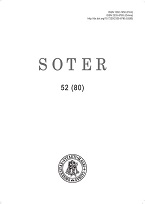Teologinės Kristaus prisikėlimo įvykio dimensijos
Theological dimensions of the event of Christ’s resurrection
Author(s): Rimas SkinkaitisSubject(s): Christian Theology and Religion
Published by: Vytauto Didžiojo Universitetas
Keywords: Prisikėlimas; Jėzus Kristus; Atnaujinimas; Perkeitimas; Žmonija Resurrection; Jesus Christ; Renewal; Transformation; Humanity
Summary/Abstract: Kristaus prisikėlimas yra viena iš kertinių krikščioniškojo tikėjimo tiesų. Tai vienkartinis įvykis, lėmęs visos istorijos raidą vilties kontekste. Straipsnyje siekiama išryškinti daugiabriaunę teologinę šio įvykio prasmę ir atskleisti Kristaus prisikėlimo įvykio teologinių dimensijų ypatumus. The truth of Jesus’ Resurrection is the pinnacle of our faith in Christ. His Resurrection is not just a onetime event that has happened sometime in the past once and for all, or an event that is finalizing and topping off the history of salvation. On the contrary, Christ’s Resurrection gives new qualitative impulse to the direction of the development of the whole history already in the light of Resurrection. It marks the beginning of eschatological times when God by resurrecting His Son finalizes the work of redemption and salvation started by Christ. By resurrecting Christ God the Father not only returns Him life, but takes the side of the downtrodden, rehabilitates Him in the eyes of the world and implements the divine justice. This way Father rehabilitates His loyal servant and Son, certifies the accuracy of His teaching, proclaimed Kingdom of God and the whole salvation activity. Moreover, by resurrecting Jesus God blesses and exalts Him to the divine glory on his right and makes Him the Head of the Church and Lord; God makes Jesus the Highest Priest who can take to heaven his offering of blood and in the most perfect way finalize the work of the salvation of human kind which He started on the Earth. Jesus’ Resurrection calls for the process of human’s liberation from evil, sin and death, which consequently results in human’s spiritual rebirth and conversion, and the creation of “new human”. This process turns to the plenitude of resurrection which will embrace the corporeal dimension of both an individual and the whole human kind, and that would allow to fully participate in Christ’s eschatological triumph.
Journal: SOTER: religijos mokslo žurnalas
- Issue Year: 80/2014
- Issue No: 52
- Page Range: 21-29
- Page Count: 9
- Language: Lithuanian

